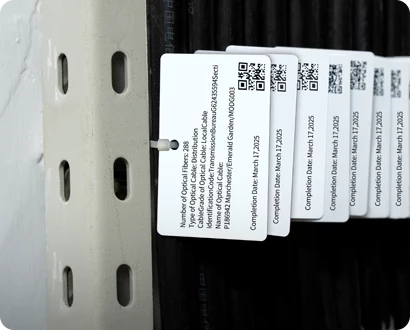How Label Printers Boost Telecom Warehouse Asset Management Efficiency?
As a core telecommunication sector underpinning the digital economy, its warehouses hold high-value assets (base station equipment, optical cables, network switches) vital for stable network operation. Yet traditional warehouse asset management has drawbacks: manual asset recording (e.g., cable models) is inefficient and error-prone; locating specific gear (e.g., 5G transceiver modules) takes too long; inventorying small-batch assets (e.g., fiber jumpers) is labor-heavy with omissions/duplicates. Luckily, technological progress brings a solution—the combination of asset management and label printers. This solution boosts warehouse asset management efficiency and accuracy, strongly supporting the telecom industry’s smooth operation.

Core Requirements for Telecom Warehouse Asset Management
Full-Process Accurate Tracking of High-Value Assets
Telecom warehouse core assets (base station gear, optical cables, network switches) are high-value with unique specs (e.g., cable transmission rates: 10G/40G/100G; switch port densities: 24/48-port), needing strict matching with network scenarios. Loss, damage, or mismatches (e.g., using multimode cables for long-distance transmission) cause heavy losses, signal issues, base station outages, and project delays. Thus, full-lifecycle tracking is key—real-time monitoring of storage locations (e.g., “Warehouse B, Shelf 5, Layer 4”), status (in use/standby/awaiting repair), and transfers to keep assets controlled.
Rapid Inventory and Deployment in Emergency Scenarios
Telecom networks face emergencies (typhoons/earthquakes damaging base stations/cables). For example, a rain-damaged 5G base station needs matching transceivers and waterproof cables within 2 hours; otherwise, tens of thousands lose service. Peak-demand scenarios (large-event support, new-area network coverage) also need urgent supplies. Warehouse management must enable fast inventory and deployment to speed up asset location/delivery, ensuring smooth repairs and project progress.

Asset Management Labels: The “Digital ID” for Telecom Warehouse Assets
In telecom warehouse management, assets like base station equipment, optical cables and network switches have diverse models, complex parameters and need to fit different network scenarios. Traditional manual asset tracking often suffers from “unclear flow, ambiguous status and disordered management”. As the “digital ID” for these assets, asset management labels solve these pain points via technical empowerment, information storage and environmental adaptability, strongly supporting full-lifecycle asset management.
Unique Identification Enabling Full-Lifecycle Tracking
Asset management labels assign each telecom asset a unique “digital ID”, integrated with QR codes/RFID chips. Their codes (e.g., “TX-5G-JJ-008”) link to backend systems. Scanning via phones/scanners accesses full-lifecycle data (procurement, deployment, maintenance, scrapping), enabling “one asset, one code, full traceability.” For example, transferring optical cables to base station sites updates their location/status automatically, fixing “unclear equipment flow” in traditional management.
Key Information to Enhance Management Accuracy
Labels clearly show core details: asset name/model (e.g., “G.652D Single-Mode Cable,” “S5735 48-Port Switch”), procurement date, maintenance cycle, and storage rules (e.g., “Anti-static for base station modules”). This lets staff grasp asset info without frequent system checks, aiding maintenance scheduling, transfer handovers, and compliant management.
Adapting to Power Warehouse Environments
To handle telecom warehouses’ diverse environments (outdoor base station assets need temperature resistance, indoor rooms are dusty, some areas have oil), asset labels use special materials: PET labels (-30℃ to 130℃, waterproof/UV-resistant) for outdoor gear; smooth vinyl labels (easy to clean, scan-friendly) for dusty indoor equipment. They keep info clear, supporting compliant asset management.

Label Printers: Core Tools Activating the Value of Asset Management Labels
On-Demand and Batch Printing Improving Warehousing Efficiency
Label printers revolutionize traditional label production via “on-demand printing,” resolving pre-print lag and waste. Staff print asset management labels on-site right after entering asset info into the system, no need for mass pre-printed blanks—avoiding obsolescence from spec changes. For example, a power material center cut single-label production time from 5 to 1 minute (handling 50+ daily assets). For batch warehousing (e.g., cable/switch port configuration), printers support Excel data import, auto-generating dozens/hundreds of labels at once—boosting efficiency over 80% vs. manual writing, and eliminating blurred info.
System Integration Ensuring Data Accuracy
Label printers seamlessly connect with power enterprises’ WMS/ERP systems, enabling “one-time entry, full synchronization.” After asset data (e.g., 10kV cable specs) is input into ERP, printers auto-generate QR-coded Asset management labels, cutting manual re-entry errors to near zero. Scanning labels accesses production batches/inspection reports, ensuring label-system data consistency. With ≥300dpi resolution, even 1cm fiber optic connector labels have 99.9% scan accuracy, preventing asset “loss” from blurred codes.
Mobile Printing Enhancing On-Site Operational Efficiency
Portable (1-2kg) mobile label printers (Bluetooth/Wi-Fi) enable “inventory while labeling.” During quarterly checks, on-the-spot printing fixes unlabeled/blurred tags, cutting inventory time from 3 to 1 day. For maintenance, on-site “to-be-repaired” labels trigger system workflows, slashing response time from 4 to 1 hour and boosting asset reuse.
Key Selection Criteria for Telecom Warehouse Asset Label Printer
When selecting label printers, telecommunication enterprises should focus on four core indicators based on warehouse environments and management needs:
Durability
Priority should be given to printers with IP54 or higher protection ratings, capable of withstanding dust, oil contamination, and splashes in warehouses, and adapting to operating temperatures of -10℃ to 50℃ to ensure stable operation in harsh environments.
Connectivity
Support for dual-mode Wi-Fi and Bluetooth connectivity, enabling seamless integration with existing WMS and ERP systems of telecommunication enterprises, realizing remote control and data synchronization, and avoiding wiring limitations of wired connections.
Print Resolution
For small-size labels such as fiber optic connector labels and micro optical module identification, printers with 300dpi or higher resolution are required to ensure clear text and barcodes; 203dpi printers can be used for large equipment labels to balance efficiency and cost.
Consumable Compatibility
Support for multiple label materials such as polyester, vinyl, and stainless steel to meet asset needs in different storage environments; simultaneous compatibility with label papers of different widths (25mm-100mm) to accommodate labeling requirements from small spare parts to large equipment.
Conclusion
The combination of asset management labels and label printers not only resolves the pain points of “low efficiency, high error rates, and time consumption” in traditional management but also builds a linkage bridge between “physical assets and digital information,” laying the foundation for the intellectualization of telecommunication warehouse management. If you happen to be looking for a solution to warehouse asset management, visit the MakeID official website to find a suitable label printer!


